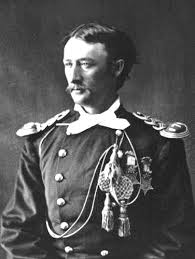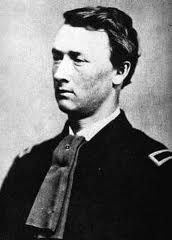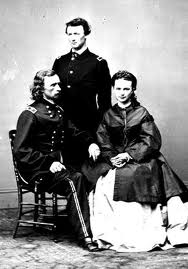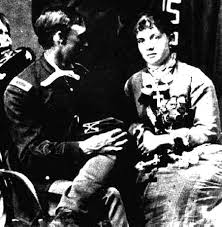 Custer Union Patriot, not George Armstrong, but his younger brother Thomas, was everything that George wasn’t, including being remembered as a Humble Hero. Thomas Custer idolized his older brother and quickly followed in his footsteps, lying about his age in order to enlist in the Civil War at the age of 16. George was vain, self-serving, a braggart and would do or say almost anything in order to further his own glory and fame. Thomas was shy, soft-spoken and had an innate ability to calmly, yet forcibly, accomplish tasks that others found insurmountable. Although the elder Custer’s exploits in the Civil War are well-known, it was Thomas Custer who was the first person to be awarded two Medals of Honor for his bravery during the Civil War. George Armstrong Custer once said of his brother, “Tom should have been the general, and I the lieutenant.”
Custer Union Patriot, not George Armstrong, but his younger brother Thomas, was everything that George wasn’t, including being remembered as a Humble Hero. Thomas Custer idolized his older brother and quickly followed in his footsteps, lying about his age in order to enlist in the Civil War at the age of 16. George was vain, self-serving, a braggart and would do or say almost anything in order to further his own glory and fame. Thomas was shy, soft-spoken and had an innate ability to calmly, yet forcibly, accomplish tasks that others found insurmountable. Although the elder Custer’s exploits in the Civil War are well-known, it was Thomas Custer who was the first person to be awarded two Medals of Honor for his bravery during the Civil War. George Armstrong Custer once said of his brother, “Tom should have been the general, and I the lieutenant.”
Thomas Ward Custer was born, March 15, 1845, in New Rumley, Ohio. He was the fifth son of the second marriages of Emanuel Custer and Maria Ward Kirkpatrick. Their first two sons died in infancy. Thomas’ brothers were George Armstrong who was born in 1839 and Nevin Johnson, born 1842. Thomas also had several half brothers and sisters. In 1860, the Custer family moved to the outskirts of Toledo, Ohio.
 In the spring of 1861, George Armstrong Custer graduated from West Point and was commissioned as a second lieutenant, just as the Civil War was beginning. Nevin, the second oldest Custer brother, enlisted in August and Thomas Custer on Sept. 2, 1861, went to the recruiting station, lied about his age, and joined the 21st Regiment of the Ohio Volunteer Infantry. The 21st became part of Army of Ohio and, later, the 14th Corps of the Army of the Cumberland and initially Private Thomas Custer was stationed in Kentucky.
In the spring of 1861, George Armstrong Custer graduated from West Point and was commissioned as a second lieutenant, just as the Civil War was beginning. Nevin, the second oldest Custer brother, enlisted in August and Thomas Custer on Sept. 2, 1861, went to the recruiting station, lied about his age, and joined the 21st Regiment of the Ohio Volunteer Infantry. The 21st became part of Army of Ohio and, later, the 14th Corps of the Army of the Cumberland and initially Private Thomas Custer was stationed in Kentucky.
At the beginning, military life was not easy for him. He had been brought up in a devoutly Christian home where he attended church every Sunday. Thomas shared a tent with 11 other soldiers and was uncomfortable with the “profanity and vulgarity” of his comrades.
The 21st Ohio fought in the Western Theater as part of the Army of the Ohio and later in the Fourteenth Corps of the Army of the Cumberland. From October 1861 until the end of 1862, the 21st Ohio participated in frequent but relatively bloodless engagements in Alabama, Kentucky and Tennessee. In December 1862, Thomas Custer participated in his first major battle at Stone’s River Tennessee. The 21st Ohio was in the center of the Federal line that was victorious. After the Battle of Stone’s River, Thomas was reassigned to escort duty on the staff of Major General James S. Negley, the 21st Ohio’s division commander. He was Negley’s escort at the Battle of Chickamauga but was not involved in the fighting. This was fortunate for Thomas as the 21st Ohio’s casualties numbered nearly half the regiment: 28 killed, 84 wounded and 131 captured or missing. After Major General James S. Negley was relieved of his command, Thomas Custer proceeded to serve in the escorts of a succession of generals including Major General U.S. Grant at Missionary Ridge and Chattanooga. Tom was with General Palmer in time for the Battle of Kennesaw Mountain on June 27, 1864 and General Jefferson C. Davis, for the Battle of Jonesboro on September 1, 1864. Thomas was with the Fourteenth Corps when William Tecumseh Sherman’s forces chased John Bell Hood’s Confederate army into Alabama.
 Brigadier General George Armstrong Custer arranged for Thomas to be commissioned a second lieutenant in Company B of the 6th Michigan Cavalry and become his aide-de-camp in late October 1864. While nepotism played a large part in Thomas’ commission, it evidently did not ease his workload. During the quiet winter months of 1864 and 1865, Thomas spent time with George and his sister-in-law Libbie near Winchester, Virginia. Encouraged and assisted by Libbie, Thomas studied and learned to be a perfect soldier and a gentleman. As for work, there was never any question of Thomas receiving preferential treatment from his brother George. When the General and his staff were awakened by news that required one of them to saddle and start off for night duty, Thomas was the one selected. Thomas had even been known to complain about George who grumbled at him for “every little darned thing just because I happen to be his brother.” However, Thomas proved his mettle at the battles of Waynesboro, Dinwiddie Courthouse, and Five Forks.
Brigadier General George Armstrong Custer arranged for Thomas to be commissioned a second lieutenant in Company B of the 6th Michigan Cavalry and become his aide-de-camp in late October 1864. While nepotism played a large part in Thomas’ commission, it evidently did not ease his workload. During the quiet winter months of 1864 and 1865, Thomas spent time with George and his sister-in-law Libbie near Winchester, Virginia. Encouraged and assisted by Libbie, Thomas studied and learned to be a perfect soldier and a gentleman. As for work, there was never any question of Thomas receiving preferential treatment from his brother George. When the General and his staff were awakened by news that required one of them to saddle and start off for night duty, Thomas was the one selected. Thomas had even been known to complain about George who grumbled at him for “every little darned thing just because I happen to be his brother.” However, Thomas proved his mettle at the battles of Waynesboro, Dinwiddie Courthouse, and Five Forks.
At Namozine Church, on April 3, 1865, three regiments of Confederate cavalry made a rearguard stand which elements of Custer’s division had to dislodge. The Northerners charged in front and flank and the Confederates broke. George wrote to Libbie the next day, “Tom in the most gallant manner led the charge of the Second Brigade… [He] is always in the advance.” For the second time that month Thomas had his horse shot from under him, captured the color-bearer and battle flag, took a dozen prisoners, including three officers and was to be awarded a Medal of Honor for his actions.
Just 3 days later, on April 6, 1865, at a crossroads near Saylor’s Creek, Custer’s 3rd Cavalry Division was pursuing the Army of Northern Virginia’s rear guard. The Custer brothers led the cavalry charge on a Confederate defensive position consisting of barricades formed from General Ewell’s supply train. Thomas Custer was the first over the barricade where he came face to face with the 2nd Virginia Reserve Battalion’s color bearer. Grabbing the Confederate battle flag, Custer demanded the sergeant’s surrender. The sergeant replied by shooting Thomas point-blank in the face with a pistol. The bullet went through Custer’s left cheek and exited his neck. Thomas, still holding the flag, drew his own revolver and shot the sergeant dead. For his second capture of an enemy flag Thomas was awarded another Medal of Honor, which made him the first to receive this dual distinction since the Medal was inaugurated in 1862.
Colonel Capehart later reported the events in a letter to Custer,
“I saw your brother capture his second flag. It was in a charge made by my brigade at Sailor’s Creek, Virginia, against General Ewell’s Corps. Having crossed the line of temporary works in the flank road, we were confronted by a supporting line. It was from the second line that he wrested the colors, single-handed, and only a few paces to my right. As he approached the colors he received a shot in the face which knocked him back on his horse, but in a moment he was upright in his saddle. Reaching out his right arm, he grasped the flag while the color bearer reeled. The bullet from Tom’s revolver must have pierced his heart. As he was falling Captain Custer wrenched the standard from his grasp and bore it away in triumph.”
 Thomas Custer was a proud twenty-year-old who received his first Medal of Honor in a ceremony on April 24, 1865 and then went home to recuperate. On May 22, 1865, he was back in Washington for his second Medal of Honor and the next day rode through the capital in the Grand Review of the Union armies. Thomas would wear his two Medals of Honor with pride at every opportunity, though he showed a healthy tendency not to take them too seriously, sometimes, however, he would allow a female acquaintance to wear his Medals for a special photograph.
Thomas Custer was a proud twenty-year-old who received his first Medal of Honor in a ceremony on April 24, 1865 and then went home to recuperate. On May 22, 1865, he was back in Washington for his second Medal of Honor and the next day rode through the capital in the Grand Review of the Union armies. Thomas would wear his two Medals of Honor with pride at every opportunity, though he showed a healthy tendency not to take them too seriously, sometimes, however, he would allow a female acquaintance to wear his Medals for a special photograph.
After the Civil War, Thomas served as his brother’s aide until January 1866 when he mustered out of the 6th Michigan Cavalry to accept a commission as a second lieutenant in the regular army. He was assigned to the newly formed 7th Cavalry. The 7th Cavalry was assigned to the Indian Campaign. Their first encounter with Indians came in mid 1867 as they chased hostiles through the Kansas plains. In 1868, he was wounded in the Washita campaign against a Cheyenne encampment. After the Washita campaign, the 7th Cavalry was distributed over seven different Southern states to conduct constabulary duties in support of the Reconstruction Act, such as enforcing federal taxes on distilleries and suppressing the activities of the Ku Klux Klan.
In 1873, the 7th Cavalry was reunited and assigned to Fort Abraham Lincoln, near Bismarck, North Dakota to protect settlers and Northern Pacific Railroad engineers from Sioux Indians. During the summer of 1873, Thomas and his men escorted Northern Pacific Railroad surveyors as they worked their way westward along the Yellowstone River in eastern Montana. While protecting the surveyors, Thomas was involved in several skirmishes with the Sioux. It was during one of these skirmishes that a Sioux Warrior named Rain in the Face killed Dr. John Honsinger and three others. Thomas Custer eventually arrested Rain in the Face in 1874. The warrior escaped from custody a few months later and vowed to cut out the heart of Thomas Custer and eat it.
On June 25, 1876, at the Battle of the Little Big Horn, Custer’s 7th Cavalry was massacred and Thomas, along with his brothers George and Boston and brother-in-law James Calhoun were killed. Thomas was scalped, disemboweled, and mutilated almost to the point of being unrecognizable. Although Rain-in-the-Face denied cutting out Thomas Custer’s heart after the battle; it has been readily accepted as fact, by those who attempted to identify his remains. His body was finally identified by a tattoo, a flag, the goddess of liberty and the initials T.W.C. on his arm. The two-time Medal of Honor winner had served his brother to the last. The brothers were initially buried together on the battlefield, in shallow graves, as was the rest of the command. In 1877, the presumed remains of George Armstrong Custer were reinterred at West Point, while those of Thomas Ward Custer and several other officers were interred at Fort Leavenworth. The rest of the command was buried in a mass grave marked by a granite monument at the Little Big Horn Battlefield.
Thomas Custer was a Union Patriot and unlike his brother, was also a Humble Hero!
Bummer


I guess it makes sense the whole Custer family couldn’t be glory hogs like their Audie. Wonder how much of the general’s success was directly attributable to Thomas? And what he advised his brother the morning of the Battle of the Little Bighorn.
Louis,
Think that all the Custer boys were pretty impetuous, couldn’t comprehend injury, death or defeat. All would probably follow Autie anywhere. Found out the true meaning of the Custer Myth in the “Greasy Grass” of the Dakotas. Thanks for reading!
Bummer